LU-8030 Errors Caused by Using Joules to Time Laboratory and Outdoor Exposure Tests
Technical Bulletins
Posted 2023
Last Updated 2023
LU-8030
Reference: Grossman, D.M., “Errors Caused by Using Joules to Time Laboratory and Outdoor Expo - sure Tests”, Accelerated and Outdoor Durability Testing of Organic Materials, ASTM STP 1202, Warren D. Ketola, and Douglas Grossman, Eds., American Society for Testing and Materials, Philadelphia, 1993.
Abstract: A common practice in laboratory or outdoor weathering tests, is to time the exposure in UV Joules instead of hours or days. The assumption is that Joules of radiant UV exposure give a relatively reliable index of the degradation forces impinging on the test specimens. However, timing in Joules can be extremely misleading. Joules do not reflect variations in degradation caused by differences in expo - sure to moisture, temperature, or wavelength spectrum of the light source. Characterization and control of these other parameters is often more important than Joules of radiant dosage. Controlled tests were conducted, varying either temperature, moisture, or wavelength spectrum while holding other conditions constant. In these tests, replicate specimens exposed to identical radiant dosage in Joules showed vari - ations of over 500% in gloss loss and yellowing. This effect was observed in several different polymers. The conclusion is that for UV exposure tests, measuring radiant dosage may be a worthwhile control, but it is by no means sufficient as a description of the test conditions.
Keywords: Ultraviolet, radiant dosage, Joules, weathering, durability, photodegradation.
Terminology:
Irradiance: The rate at which light energy falls on a surface, expressed in W/m 2 .
Spectral Irradiance: The distribution of irradiance with respect to wavelength.
Spectral Power Distribution (SPD): see Spectral Irradiance.
Radiant Dosage: The accumulated light energy which has fallen on a surface over a period of time. This is the integrated product of irradiance and time, expressed in J/m 2 .
Joule: An amount of energy equal to 1W x 1s. For purposes of simplicity in this paper, we’ve adopted the common usage of the term Joule to also refer to Radiant Dosage.
Total UV (or TUV) The radiant dosage of light of a wavelength shorter than 385 nm, expressed in J/m 2 .
Joules at 340 nm: For purposes of this paper, the radiant dosage of UV light of a wavelength of 340 nm, expressed in J/m 2
Langley: An obsolete measure of total dosage from sunlight, including visible light, UV, and infrared. 1
Langley = 41,840 J/m 2 .
Background: Joules Create the Illusion of Precision
The variability of the weather is proverbial. Historically, scientists interested in testing the durability of materials exposed outdoors have faced the problem of large variability in their test results. Replicate samples exposed outdoors for the same amount of calendar time typically exhibited large differences in the amount of degradation. The reasoning followed that, since “the weather” is so variable over time, the calendar is not an accurate indicator of the amount of stress a test sample has received. Based on the concept that sunlight was the major cause of “weathering” degradation, early efforts to compensate for seasonal, geographical and annual variances in test results focused on measuring sunlight and then timing the exposure tests based on accumulated radiant exposure dosage. It was thought that these measurements would give a more accurate measure than the calendar. Unfortunately, sunlight is often not the only factor controlling degradation.
Early efforts at timing tests by radiant dosage measured total radiant energy, including visible and in - frared wavelengths (expressed in Langleys). Instead of reporting the number of months an exposure ran, investigators reported the number of Langleys the specimens received. The energy from sunlight is mainly visible light and IR. UV makes up only about 5% of sunlight. However, the photodegradation of exterior grade materials is mainly caused by UV.
Earlier work has shown that replicate specimens receiving the same dosage of total Joules or Langleys showed variation in degradation of as much as 6 to 1. Consequently, the Langley method has been largely discredited [1] [2]. Unfortunately, the problem of variability in outdoor test results remains.
Current fashion now dictates the use of UV radiant exposure as the appropriate means of timing tests. Using Total UV Joules (TUV) seems more reasonable than using Langleys. In fact, TUV has some usefulness for correlating outdoor exposures of textiles and other relatively non-durable materials.
There is a seductive simplicity to this concept. If an exposure test could be characterized by one magic number (Joules), then the results could be easily compared to exposures performed at different times or places. Furthermore, outdoor exposures could be compared to accelerated laboratory tests. And different types of laboratory light sources could be compared to each other. Because controlling the UV irradiance in laboratory testers is certainly a step forward for improved reproducibility, it’s easy to take one more step and use UV radiant dosage as the sole index of test severity.
Unfortunately, the data shows that timing tests in UV Joules does not adequately describe the degradation forces in an exposure test. Replicate specimens receiving the same accumulated radiant dosage often show vastly different degradation. This is because timing in Joules does not take into account the substantial variations in weathering stress caused by the following other factors:
- Differences in Spectral Irradiance.
- Differences in Exposure Temperature.
- Differences in Moisture Exposure.
It will be demonstrated that these factors can cause replicate test specimens to show differences in degradation of more than 5 to 1 (500%) when exposed to an identical number of Joules. This is true whether the Joule measurements are Total UV, or UV at a specific wavelength, such as 340 nm. Depending on the material tested, any of these three factors can actually be more important than the UV radiant dosage.
Significant errors can result when researchers are seduced into comparing test results based on accumulated radiant dosage. Although at first blush, Joules may seem to be the pinnacle of scientific sophistication, a deeper understanding of exposure tests reveals that timing in Joules is a dangerous oversimplification. Joules are simply not a reliable index of the degradation forces impinging on the test specimens.
Joules Errors Due to Wavelength
The wavelength spectrum of sunlight changes constantly. Both the amount of UV, and the shape of the sunlight SPD curve vary depending on time of day, time of year, cloud cover, air pollution, and geographical latitude. For instance, Fig 1 shows the wavelength shift due to just the seasonal change in sun angle [1]. Note that the winter SPD is totally lacking the shortest and most damaging wavelengths, below about 310 nm.
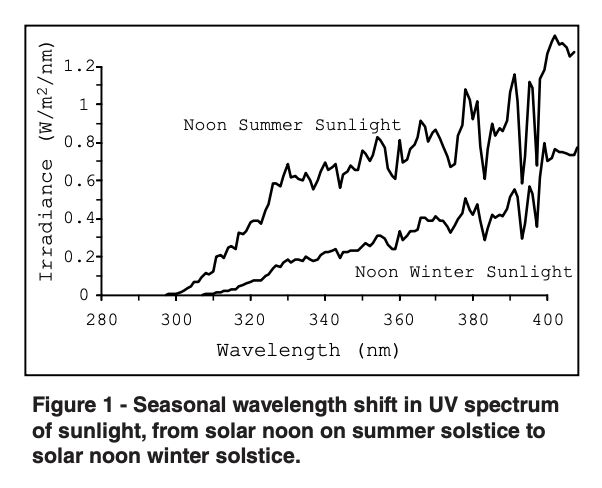
There are also wide differences in the SPD of various laboratory exposure devices. Fluorescent UV testers can use any of 3 types of lamps; xenon arc testers can use various filter combinations; and carbon arc testers use 2 very different types of light sources. Furthermore the shape of the SPD curve in xenon lamps changes as the lamps age [3]. If Joules were to be valid for timing exposure tests, they would compensate for these variations in SPD that occur both outdoors and in the laboratory. However, the data shows that even minor differences in SPD can cause major problems in using Joules to time exposures.
Many studies show that, in general, a Joule of short wavelength UV is more damaging than a Joule of longer wavelength UV. For example, as seen in Figure 2, polyolefins exposed to 1 MJ/m2 of UV at various wavelengths showed 5 to 10 times greater carbonyl formation at a wavelength of 280 nm than at 340 nm [4]. Such studies suggest that timing exposure tests in Joules could lead to huge errors unless the spectral power distributions of the light sources compared were absolutely identical.
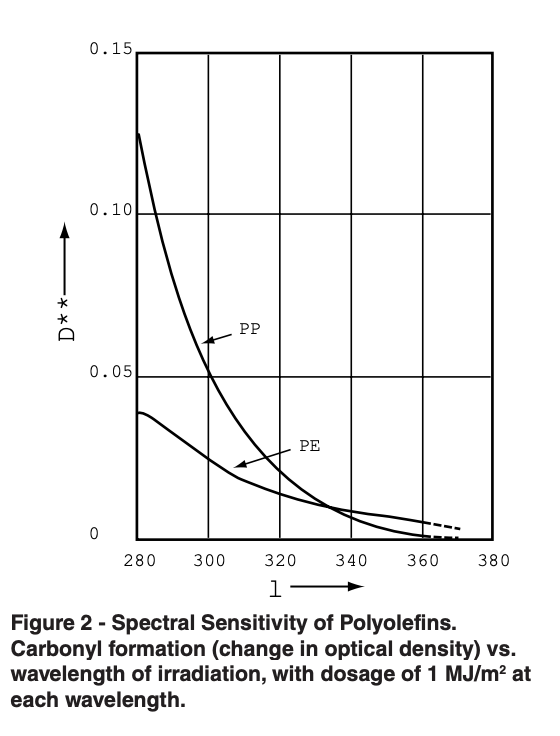
To make a direct illustration of errors caused by wavelength differences, replicate samples of several materials were exposed according to ASTM G 53, Standard Practice for Light and Water Exposure Apparatus (Fluorescent UV Type). Each exposure used fluorescent UV lamps with one of the two different wavelength spectra shown in Fig 3. The G 53 devices were Model QUV/se from Q-Lab Corporation. These devices were equipped with feedback controls that allowed precise control of irradiance and UV dosage, as described in another paper in this symposium [5]. For these tests the irradiance was controlled at 1.35 W/m2 /nm at 340 nm. Fluorescent UV devices provide an ideal vehicle for examining effects of SPD, because unlike other types of lamps, the shape of the SPD curve does not change during the life of the fluorescent UV lamp [3].
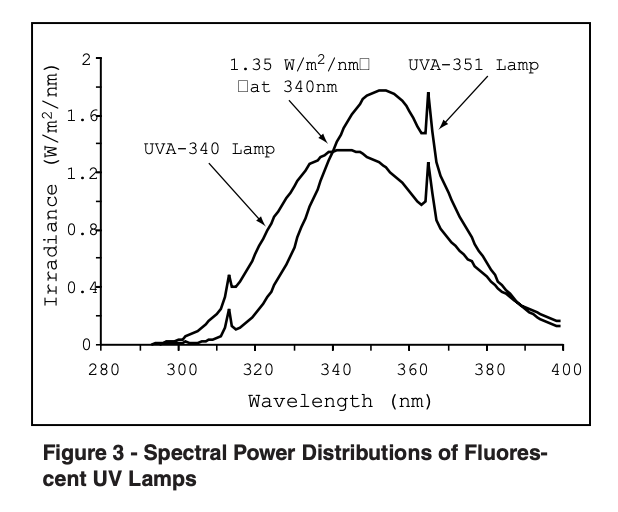
To eliminate effects of moisture, the exposures were run with continuous UV and no condensation. To eliminate the effect of temperature, the exposure temperature was kept at 50°C.
Note that the SPD curves of the UVA-340 and UVA-351 lamps are only shifted by 10 nm — an apparently small amount, and much less than the difference between summer and winter sunlight shown in Figure 1. However, the following tests shows differences of up to 2:1 in the degradation per Joule of radiant dosage.
Figure 4 shows that the longer wavelength lamp, the UVA-351, required about 80% higher dosage of Total UV than the UVA-340 to cause a given amount of yellowing (delta b*), on clear polystyrene plaques. If the researcher were relying on radiant dosage in Joules to time these tests, this would represent a rather significant error.
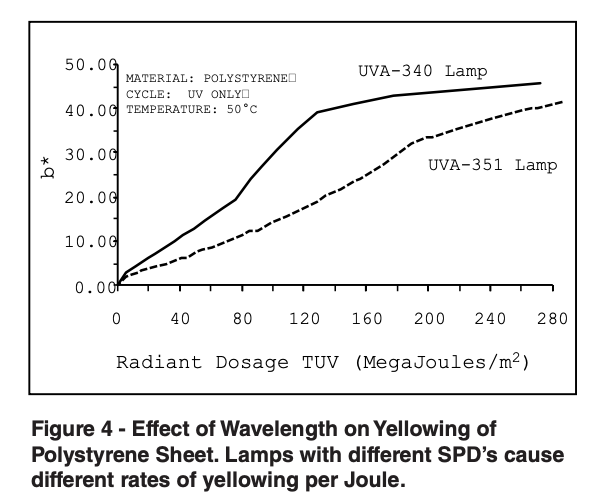
Figure 5 shows a similar effect for gloss loss of an epoxy paint. In this case, compared to the UVA-340 lamp, the UVA-351 requires about twice the Total UV to produce a given gloss loss.
It is sometimes asserted that more accurate timing of tests can be achieved by using Joules at 340 nm instead of Total UV Joules. Figure 6 shows the same data as Figure 5, but expressed in terms of UV Joules at 340 nm instead of Total UV Joules. This does not improve the precision of the timing. The UVA-351 still requires almost twice as many Joules as the UVA-340 to produce a given gloss loss. This is consistent with the data in Figure 5.
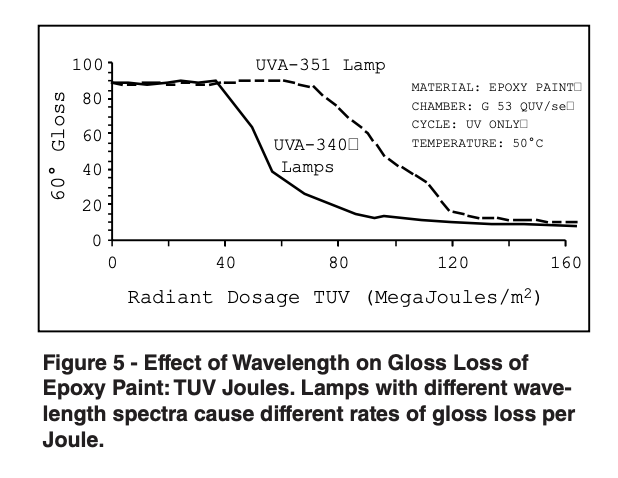
Figure 7 shows that although wavelength spectrum can have a huge effect, sometimes it has little effect. In this case the UVA-340 and UVA-351 lamps show about the same gloss loss per Joule, despite the differences in their SPD’s.
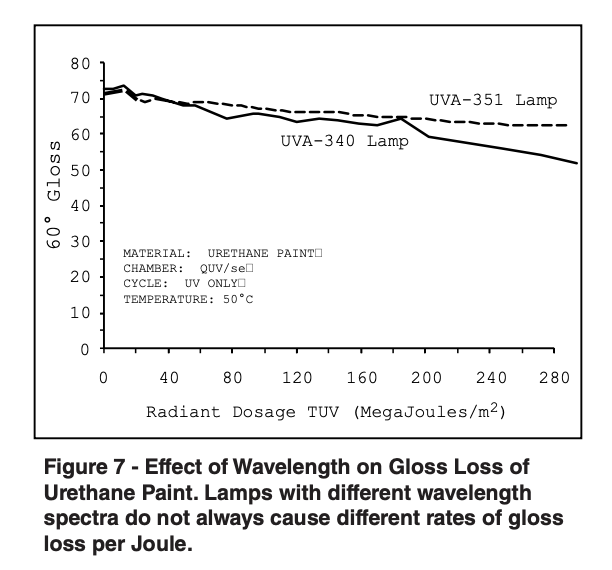
The data above show that a small change in wavelength spectrum can cause degradation per Joule of exposure to vary by 2 to 1. In other words, for exposure tests that do not have identical SPD curves, timing the tests in Joules can lead to errors of over 200%. This is true regardless of whether the Joules represent Total UV or Joules at a specific wavelength such as 340 nm.
The normal variation in the UV spectrum of natural sunlight is much greater than the variation between the two types of UV lamps used above. The SPD of solar UV varies dramatically, depending on time of day, season, cloud cover, and pollution (see Figure 1). It’s reasonable to expect that degradation per Joule will vary with these changes in SPD. Yet when outdoor exposures are timed in Joules, it’s routine to indiscriminately lump together summer Joules and winter Joules, or 10:00 AM Joules and noon Joules, despite the known differences in wavelength spectrum.
Joules Errors Due to Temperature
Outdoor exposure temperature is constantly changing due to the weather. Also the sample mounting method has a large effect on temperature. Samples mounted vertically are cooler than samples mounted horizontally because they receive less sunlight. And samples with insulated backing can be over 10°C hotter than unbacked samples. Likewise in laboratory tests, the operator can choose a wide range of temperatures. Furthermore, different methods of temperature measurement result in different actual specimen temperatures in laboratory devices. For instance in xenon testers a “Black Panel” temperature of 80°C can give the same specimen temperature as a “Black Standard” temperature of 100°C [6]. And a fluorescent UV tester with a Panel Temperature of 80°C would be expected to have a different specimen temperature than either xenon method. It is well known that otherwise identical exposures at different temperatures can exhibit radically different degradation.
Fischer has demonstrated this for outdoor exposures by filling an entire outdoor rack with replicate specimens of a blue PVC film [7]. The film’s initial 60° gloss was 90. Figure 8 shows that after 18 months of Florida exposure, the specimens in different parts of the rack showed gloss ranging from 36 to 67, with specimens in the center of the rack showing the most degradation. Further investigation showed that the differences in degradation were caused by different average specimen temperatures due to the cooling effect of wind on the edges of the rack.
All of these identical specimens received exactly the same radiant dosage at every wavelength, but with very different effects. A Joule in the center of the rack was twice as damaging as a Joule at the edge. This suggests that timing outdoor exposures in Joules instead of calendar time gives only the illusion of precision.
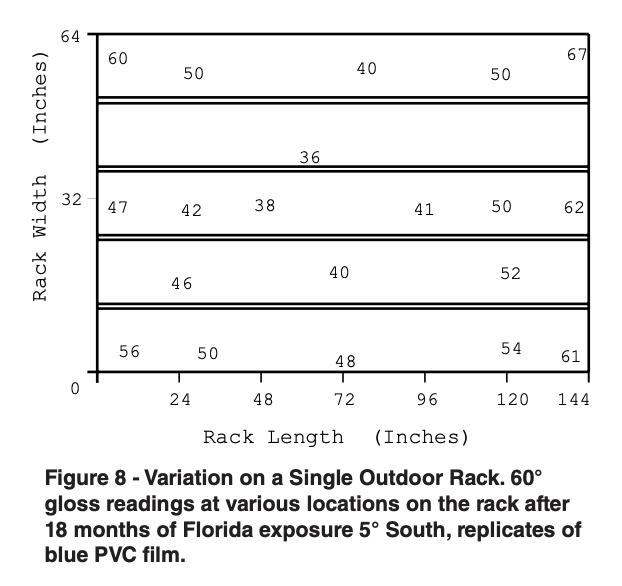
In another paper, Fischer noted that in a xenon arc tester, doubling the irradiance actually caused reduced yellowing of polystyrene reference plaques, because it was accompanied by a 16°C reduction in specimen temperature [8]. Table 1 shows that at 42°C it took over twice as many Joules to cause the same yellowing as at 58°C.
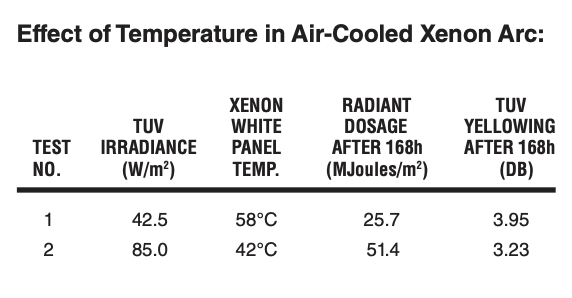
Polystyrene degradation per Joule at 58°C is twice as much as at 42°C.
To systematically demonstrate the effect of temperature on a variety of materials, we exposed replicate specimens in the G 53 fluorescent UV devices at 50°C and at 70°C.
To eliminate any moisture effect, the exposures were continuous UV, with no moisture. To eliminate the effects of wavelength, all exposures used UVA-340 lamps with irradiance set at 1.35 W/m2 /nm at 340 nm. Thus the exposures all received identical radiant exposure at all wavelengths.
Figure 9 shows that for a polycarbonate sheet to yellow a given amount required about 50% more Joules at 50°C than at 70°C. Figure 10 shows that for an ABS sheet, the yellowing per Joule was about twice as much at 70°C as at 50°C.
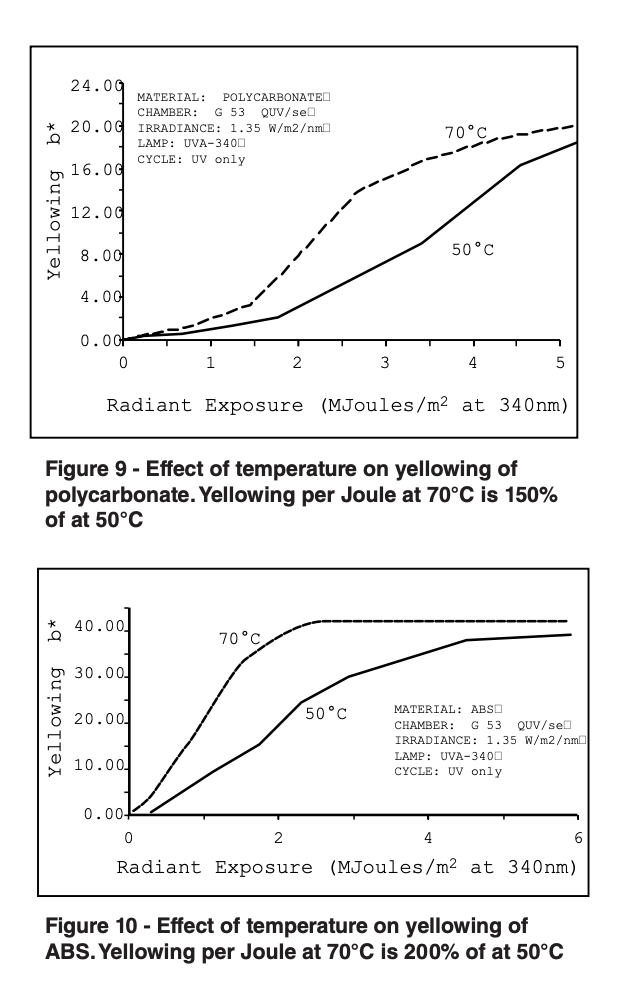
It is important to remember that not all materials show increased degradation rates with increased temperature. Therefore, it is not possible to derive a general equation that relates temperature and acceleration. Figure 11 shows a urethane paint that has approximately the same degradation per Joule at 50°C and 70°C.
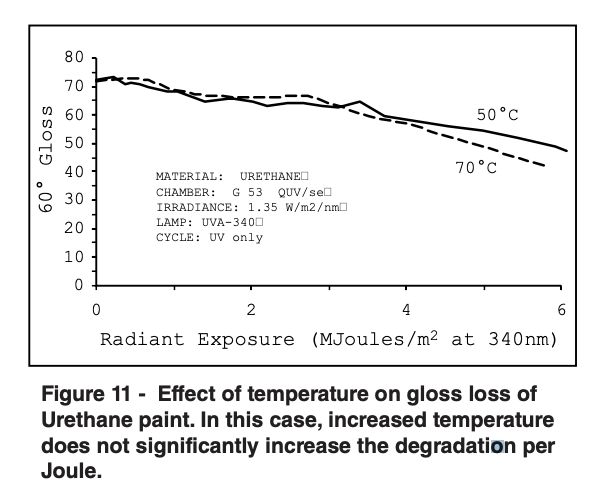
The above data show that in both outdoor and laboratory exposures, specimens exposed to equal Joules but different temperatures can show varia - tions in degradation of 2:1. Again, Joules are not a good measure of the weathering stresses received by the specimen.
The exposures all received identical radiant expo - sure at all wavelengths. So although Joules at 340 nm are reported above, TUV Joules, UV-B Joules, or Joules at any wavelength would give the same degradation curves and show the same variation in degradation per Joule.
In fact, plotting degradation against hours would also give the same shape degradation curves. Be - cause irradiance in this test is controlled at a fixed level of 1.35 W/m 2 /nm, timing the test in Joules gives no additional information that is not implicit in timing in hours. You can calculate the conversion between hours and J/m 2 at 340 nm by using the fol - lowing simple arithmetic: 1.35J/m 2 x 3600 seconds = 4860J/m 2 per hour. Or conversely 1 MJ/m 2 = 206 hours. However, because the object of the test was to show whether Joules are a good measure of the degradation forces on the specimen, the above graphs show degradation vs. Joules, not time.
Joules Errors Due to Moisture
Moisture is known to play an important part in polymer degradation, both outdoors and in the laboratory. In outdoor exposures, moisture varies according to season, mounting method, and location. For instance, Florida exposure produces much greater moisture attack than Arizona. In laboratory tests, the operator can choose widely varying moisture cycles. Also, different test cham - bers have different kinds of moisture simulations. Fluorescent UV testers produce moisture via hot condensation; xenon arc and carbon arc testers use cold spray.
To illustrate how moisture affects degradation per Joule, replicates of various materials were exposed to G 53 fluorescent UV testers under the following different test cycles:
Cycle A 4 h UV, 4 h Condensation
Cycle B 4 h UV, 4 h Dark Dry (no moisture)
Cycle C 4 h Condensation, 4 h dark dry (no UV)
To eliminate the effects of wavelength, all expo - sures used UVA -340 lamps with irradiance set at 1.35 W/m 2 /nm at 340 nm. To eliminate the effect of temperature, all exposures were kept at 50°C. Figure 12 shows the effect of moisture on gloss loss of an epoxy paint. In this case the cycle with - out moisture takes about twice as many Joules to produce gloss loss equivalent to the cycle with moisture.
Figure 13 shows similar data for a urethane paint. The degradation per Joule is at least 500% greater with the cycle that contains condensation than with the cycle without moisture. Once again degradation does not correspond to Joules of exposure.
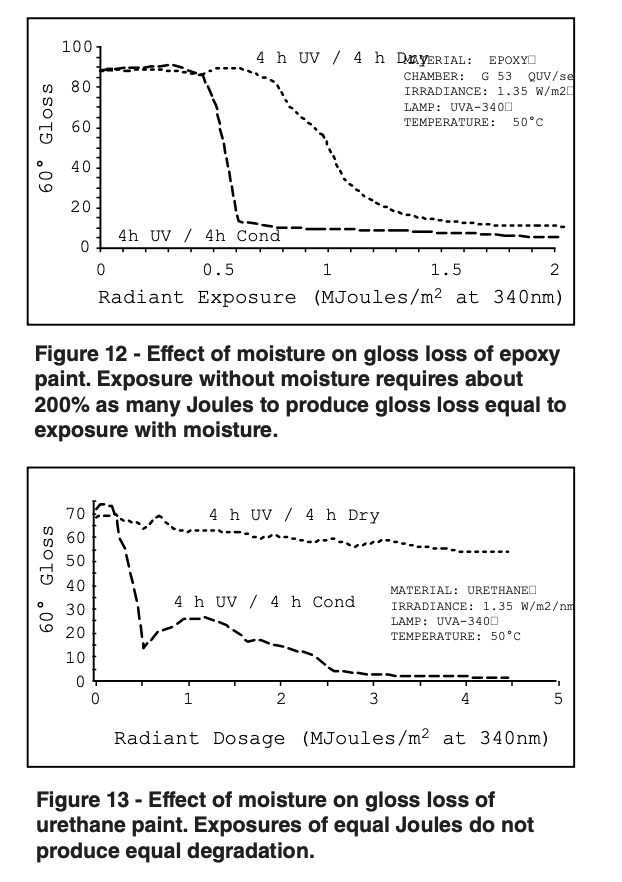
Synergy of UV and Moisture : Figure 14 adds to this data a cycle of 4 h Cond and 4 h Dark Dry. However, because this new cycle has no UV, it’s impossible to graph gloss vs. radiant dosage. In - stead we graph gloss vs. hours of exposure, which in this case does not significantly alter the shape of the degradation curves. Note that no gloss loss oc - curs on either the cycle that lacks UV or the cycle that lacks moisture. It is only the synergistic effect of moisture and UV in combination that causes degradation. Since the effect of UV is contingent on the co-effect of moisture, it’s obviously not mean - ingful to time the exposure with radiant dosage in Joules.
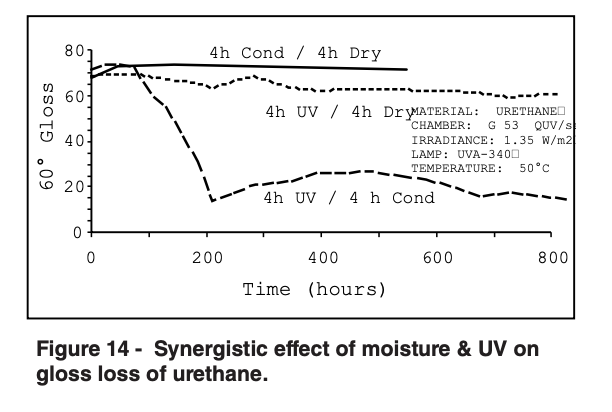
Not only does moisture affect the rate of change, it also can affect the type of degradation. Figure 15 shows yellowing of a nylon sheet versus Joules of exposure. The cycle without moisture causes yellowing. The cycle with moisture causes the opposite color shift. Visual inspection of the specimens indicates that the cycle with moisture causes appearance of a white chalk, while the cycle without moisture does not. In a case like this it’s meaningless to time degradation in Joules, since identical specimens with identical exposures in Joules exhibit two radically different modes of degradation due to the presence of moisture.
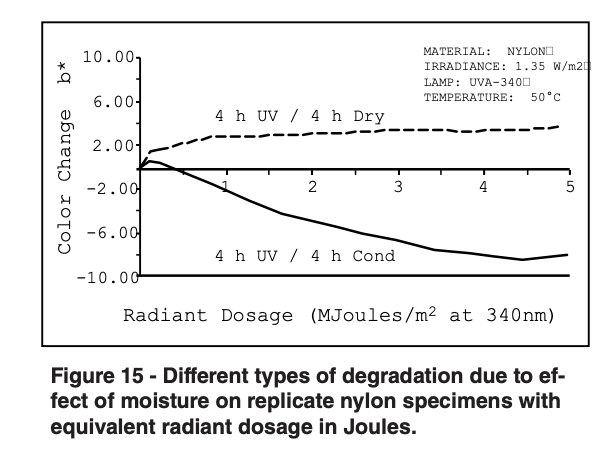
It’s also important to remember that moisture is not always an important degrading force. Figure 16 shows that for the polystyrene sheet, moisture does not effect the rate of yellowing. In this case Joules at 340 nm does provide a good measure of the degradation forces. On the other hand, ordinary test hours would work just as well for timing this test.
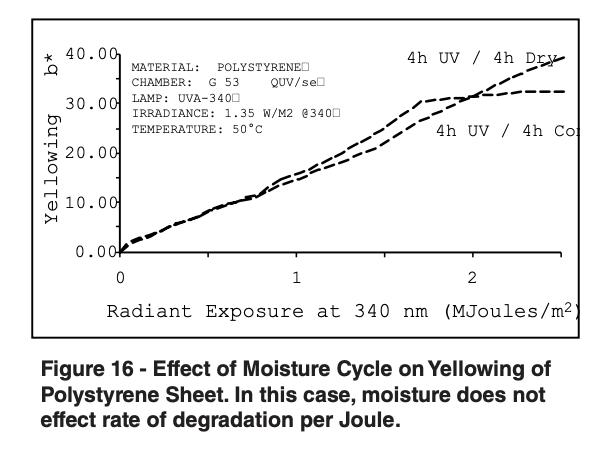
The above data demonstrate that for replicate materials exposed to identical levels of radiant dosage, variations in moisture caused differences in both rate of degradation and type of degradation. For this reason it is not advisable to use radiant dosage in Joules as a method of timing exposure tests where there might be a difference in moisture exposure.
Unexplained Joules
Errors Even when wavelength, temperature, and moisture cycle are apparently controlled, it is still possible to have very large variations in the rate of degradation per Joule. A recent round robin study included data on several xenon arc devices per ASTM G 26, all operated in identical fashion [9]. The xenon arcs were operated according to SAE J1960 with quartz inner filters and borosilicate outer filters at an irradiance level of 0.55 W/ m2 at 340 nm. The cycle was 40 minutes of light only, 20 minutes light and front spray, 60 minutes light only, and 60 minutes dark with back spray. Temperatures were 70°C during light and 38°C during spray. Figure 17 shows that there were major variations in gloss loss per Joule among 5 labs exposing replicate vinyl films to this cycle. For instance, Lab IV required about 300% as many Joules as Lab VIII to cause a given gloss loss. It’s not known whether the variation in degradation per Joule is caused by temperature differences, moisture difference, or by changes in the SPD of the xenon lamps. However, it’s clear that in this case Joules do not provide an accurate measure of the degradation forces received by the specimens.
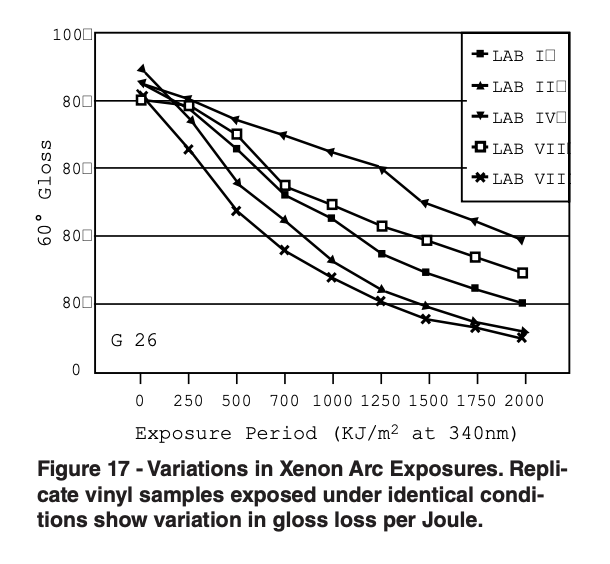
Conclusions
It is erroneous to believe that timing weathering tests in Joules of radiant dosage leads to a precise measure of the degradation forces impinging on the test sample. Exposures of equal Joules do not necessarily produce equivalent degradation. On the contrary, timing in Joules can lead to errors of over 500%. This is true whether the Joules measured are Total UV, or UV at a given wavelength such as 340 nm. The main reasons for these errors are:
- Joules do not account for the effect of wavelength.
- Joules do not account for the effect of temperature.
- Joules do not account for the effect of moisture.
Temperature, moisture, and wavelength spectrum all vary widely, both outdoors and in laboratory tests. In controlled tests, the number of Joules required to cause failure of replicate specimens varied by up to 500%, depending on variations in temperature, moisture, and wavelength. This effect was shown in a number of different materials, including epoxy, urethane, polystyrene, PVC, polycarbonate, ABS, and nylon. Furthermore, the magnitude of the effects varied depending on the material tested, so it’s not possible to derive an equation that relates temperature or moisture to degradation per Joule.
In addition, in some materials the presence or absence of moisture resulted in radically different types of degradation in replicate exposures with identical radiant exposure. In such cases, timing the test in Joules is totally meaningless.
Joules are either misleading or redundant. If two exposure tests do not have identical temperature, moisture, and wavelength spectrum, then timing the tests in Joules is very misleading. If the tests do have identical temperature, moisture, and wavelength, then Joules are redundant — they give you no more information than timing the tests in hours. Although controlling UV irradiance is a worthwhile step in laboratory tests, measuring UV radiant dosage is by no means a sufficient description of the exposure conditions. Joules are not the degrading force in weathering tests — they are only one of several. Since degradation per Joule is so elastic, timing exposure tests with Joules is like measuring distance with a rubber ruler.
Acknowledgments
The author would like to thank Gregory Fedor and Sandra Kalmbach for essential work in collecting and organizing data.